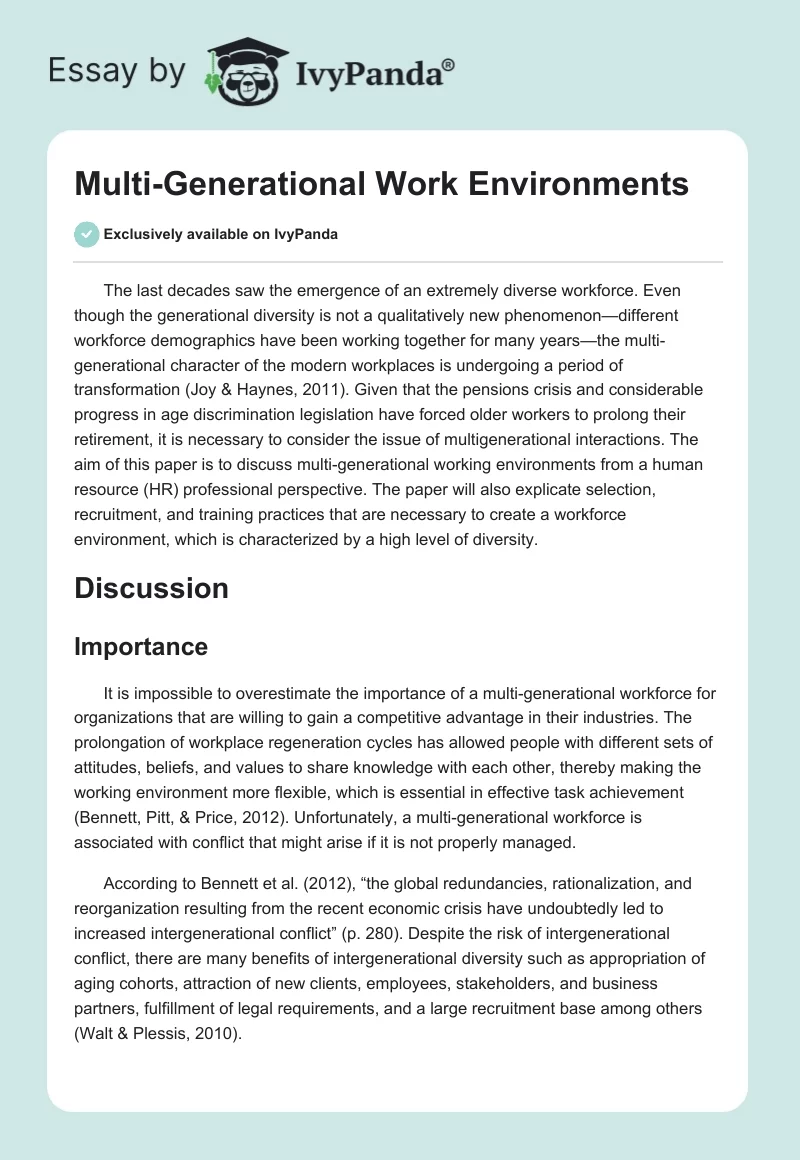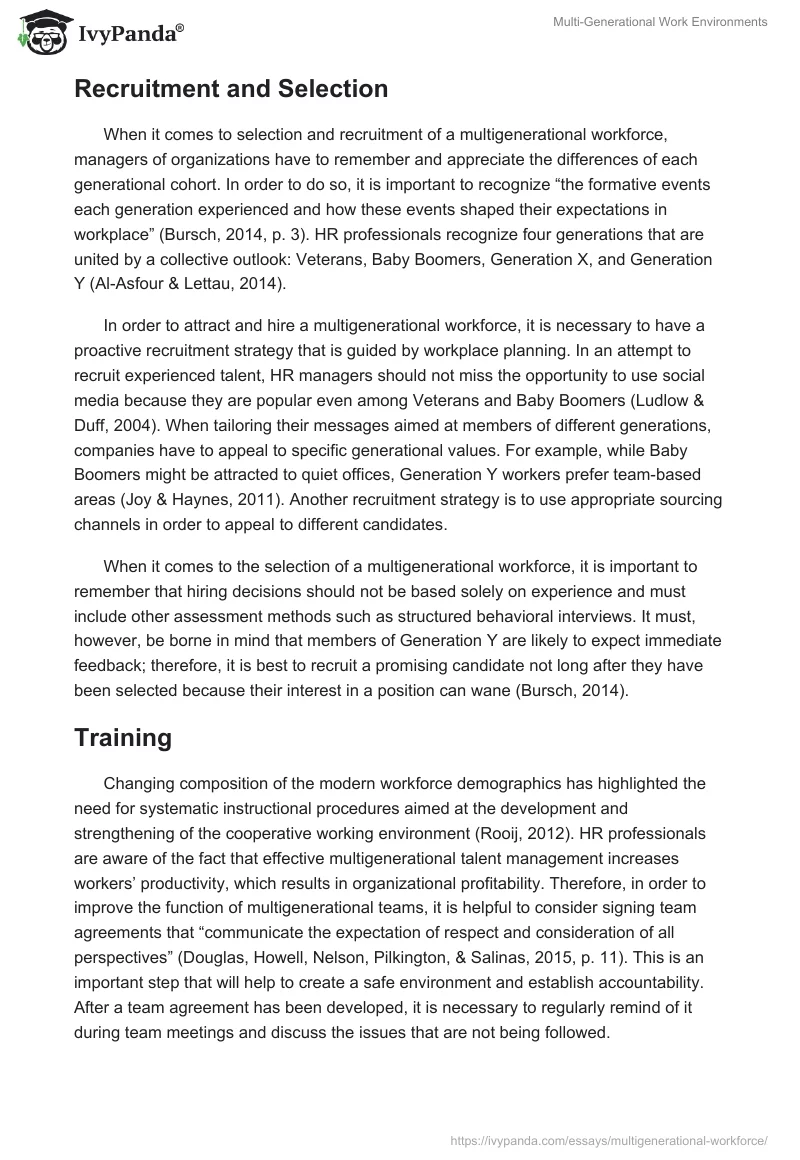The last decades saw the emergence of an extremely diverse workforce. Even though the generational diversity is not a qualitatively new phenomenon—different workforce demographics have been working together for many years—the multi-generational character of the modern workplaces is undergoing a period of transformation (Joy & Haynes, 2011). Given that the pensions crisis and considerable progress in age discrimination legislation have forced older workers to prolong their retirement, it is necessary to consider the issue of multigenerational interactions. The aim of this paper is to discuss multi-generational working environments from a human resource (HR) professional perspective. The paper will also explicate selection, recruitment, and training practices that are necessary to create a workforce environment, which is characterized by a high level of diversity.
Discussion
Importance
It is impossible to overestimate the importance of a multi-generational workforce for organizations that are willing to gain a competitive advantage in their industries. The prolongation of workplace regeneration cycles has allowed people with different sets of attitudes, beliefs, and values to share knowledge with each other, thereby making the working environment more flexible, which is essential in effective task achievement (Bennett, Pitt, & Price, 2012). Unfortunately, a multi-generational workforce is associated with conflict that might arise if it is not properly managed.
According to Bennett et al. (2012), “the global redundancies, rationalization, and reorganization resulting from the recent economic crisis have undoubtedly led to increased intergenerational conflict” (p. 280). Despite the risk of intergenerational conflict, there are many benefits of intergenerational diversity such as appropriation of aging cohorts, attraction of new clients, employees, stakeholders, and business partners, fulfillment of legal requirements, and a large recruitment base among others (Walt & Plessis, 2010).
Recruitment and Selection
When it comes to selection and recruitment of a multigenerational workforce, managers of organizations have to remember and appreciate the differences of each generational cohort. In order to do so, it is important to recognize “the formative events each generation experienced and how these events shaped their expectations in workplace” (Bursch, 2014, p. 3). HR professionals recognize four generations that are united by a collective outlook: Veterans, Baby Boomers, Generation X, and Generation Y (Al-Asfour & Lettau, 2014).
In order to attract and hire a multigenerational workforce, it is necessary to have a proactive recruitment strategy that is guided by workplace planning. In an attempt to recruit experienced talent, HR managers should not miss the opportunity to use social media because they are popular even among Veterans and Baby Boomers (Ludlow & Duff, 2004). When tailoring their messages aimed at members of different generations, companies have to appeal to specific generational values. For example, while Baby Boomers might be attracted to quiet offices, Generation Y workers prefer team-based areas (Joy & Haynes, 2011). Another recruitment strategy is to use appropriate sourcing channels in order to appeal to different candidates.
When it comes to the selection of a multigenerational workforce, it is important to remember that hiring decisions should not be based solely on experience and must include other assessment methods such as structured behavioral interviews. It must, however, be borne in mind that members of Generation Y are likely to expect immediate feedback; therefore, it is best to recruit a promising candidate not long after they have been selected because their interest in a position can wane (Bursch, 2014).
Training
Changing composition of the modern workforce demographics has highlighted the need for systematic instructional procedures aimed at the development and strengthening of the cooperative working environment (Rooij, 2012). HR professionals are aware of the fact that effective multigenerational talent management increases workers’ productivity, which results in organizational profitability. Therefore, in order to improve the function of multigenerational teams, it is helpful to consider signing team agreements that “communicate the expectation of respect and consideration of all perspectives” (Douglas, Howell, Nelson, Pilkington, & Salinas, 2015, p. 11). This is an important step that will help to create a safe environment and establish accountability. After a team agreement has been developed, it is necessary to regularly remind of it during team meetings and discuss the issues that are not being followed.
In addition to establishing team agreements, managers should conduct one-on-one coaching based on unique characteristics of each generation group and individual capabilities of team members. Given that members of Generation X and Generation Y have been strongly influenced by their parents, they are open to being coached by mature HR professionals who are willing to share their experience and knowledge (Douglas et al., 2015). Members of Generation X are individualistic and self-accountable; therefore, it is recommended to use active listening skills when coaching them.
It is important to conduct communication skills workshops in order to enhance team cohesion. Such workshops should include exercises that focus on generational self-discovery and allow participants to better understand generational tendencies of their colleagues. Younger employees will appreciate interactive web-based trainings, case presentations, and video vignettes (Harfoushi & Ruba, 2011). Role playing and lectures can be used to engage Veterans and Baby Boomers (Douglas et al., 2015).
Unbiased Hiring Framework
The development of an unbiased hiring process is especially important in the modern, fast-paced work environment. The pressures of increased competition make some companies more suspicious of hiring individuals belonging to older cohorts. Such biased employment practices reduce opportunities for unprotected people. In order to avoid selecting, interviewing, and recruiting decision errors, it is important to avoid bias that can arise during all sequential steps of the employment process (Savage, 2014).
Unbiased hiring starts at job analysis phase. It is essential to avoid bias when identifying minimally acceptable knowledge, skills, and abilities necessary to perform a job. When it comes to recruitment phase, it is necessary to advertise job openings without leaving potential applicants belonging to older generations unaware of them. Furthermore, it is necessary to avoid using loaded words in job advertisements. The following words exemplify youth bias: high energy, fast passed, and fresh thinking (Savage, 2014). In order not to discriminate against highly qualified candidates from all generational cohorts, words such as experience and expertise should be used.
Even though HR managers should be cognizant of a quantitative balance of their workforce composition in order to avoid diminished diversity, they, nonetheless, have to be focused on finding the right candidate. Therefore, at the interviewing phase, it is recommended to have interviewers of different backgrounds and ages, which will help to escape the trap of unintentional discrimination.
Conclusion
The paper has discussed multi-generational working environments and explicated selection, recruitment, and training practices that are necessary to create a workforce environment, which is characterized by a high level of diversity and tolerance. It has been shown that HR professionals have to safeguard their companies from attracting and hiring potential candidates based on unintentional age discrimination.
References
Al-Asfour, A., & Lettau, L. (2014). Strategies for leadership styles for multi-generational workforce. Journal of Leadership, Accountability and Ethics, 11(2), 58-69.
Bennett, J., Pitt, M., & Price, S. (2012). Understanding the impact of generational issue in the workplace. Facilities, 30(7-8), 278-288.
Bursch, D. (2014). Managing the multigenerational workplace.
Douglas, M., Howell, T., Nelson, E., Pilkington, L., & Salinas, I. (2015). Improve the function of multigenerational teams. Nursing Management, 12(1), 11-15.
Harfoushi, O., & Ruba. O. (2011). E-Training acceptance factors in business organizations. International Journal of Emerging Technologies in Learning, 6(2), 15-18.
Joy, A., & Haynes, B. (2011). Office design for the multi-generational knowledge workforce. Journal of Corporate Real Estate, 13(4), 216 – 232.
Ludlow, B., & Duff, M. (2004). Online training and staff development: Facilitating a program’s global outreach. Journal of Intellectual Disability Research, 48(1), 506 -515.
Rooij, S. (2012). Training older workers: Lessons learned, unlearned and relearned from the field of instructional design. Human Resource Management, 51(2), 281-298.
Savage, Z. (2014). Human resource management: A contemporary approach. New York, NY: CreateSpace Independent Publishing Platform.
Walt, S., & Plessis, T. (2010). Leveraging multi-generational workforce values in interactive information societies. Journal of Information Management, 12(1), 1-7.


